

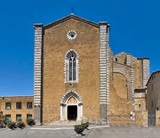
The Dominicans took over an existing church here in 1232 that was dedicated as Santa Maria della Pace. In 1235, Pope Gregory IX granted indulgences and also requested subsidies from the Commune in order to finance the construction of a new church on the site. This seems to have been the first in Italy to be dedicated to St. Dominic (who was canonised in 1234). The Dominicans held a general chapter here in 1245.
The Dominican Fra Costantino Medici, the author of a Legenda Sancti Dominici (1246-7), was bishop of Orvieto in the period ca. 1250-6. In 1254, he promulgated an indulgence for those celebrating the feasts of St Dominic and of the newly-canonised St Peter Martyr at San Domenico.
This church and the adjacent convent became particularly important during the period that Pope Urban IV and the papal curia spent in Orvieto in 1262-4. The German St Albert the Great apparently stayed at San Domenico at this time. His pupil, St Thomas Aquinas, taught theology at the convent in 1261-5, and it was during this period that he composed the Office of Corpus Christi at the behest of Urban IV to celebrate the miracle of Bolsena.
Urban IV consecrated San Domenico in 1264, although it is possible that its nave was not completed until ca. 1285. The carving of the capitals in the choir (the only part of the church that now survives - see below) suggests that this part of it was rebuilt in the late 13th century.
Four cardinals who died in the 13th century while the papal court was in Orvieto were buried in the church :
-
✴Hugh of St Cher (Ugo di San Caro, in 1263), the first Dominican cardinal, at the court of Urban IV;
-
✴two members of the court of Pope Gregory X:
-
•Annibaldo d' Annibaldi della Molara, another Dominican cardinal (in 1272);
-
•Eudes de Chateauroux (in 1273); and
-
✴Guillaume de Bray (in 1282), at the court of Pope Martin IV.
All four must have had important monuments, but only the last of these (see the page on the Monument to Cardinal de Bray) survives.
The relics of the Blessed Jane (Giovanna, Vanna) of Orvieto, a Dominican tertiary, were translated to San Domenico in 1307. Although she had been dead for some 15 months, her body was apparently uncorrupt. Pope Benedict XIV confirmed the cult of the Blessed Jane of Orvieto in 1754. Her relics were translated to her native Carnaiola in 2000.
The roof of the church and convent were destroyed by fire in 1311, and the complex was abandoned again for an unknown reason in the period 1380-1401. The church was remodelled in the Baroque style in 1680, which involved the demolition of half of the nave and the adaptation of the aisles into side chapels.
However, the most catastrophic event came in 1934 when the Fascist government destroyed the nave of the church and adjoining convent to make way for the Accademia Femminile di Educazione Fisica (a girls' school for physical exercise that later passed to the military), which is to the left in the photograph below.
Exterior
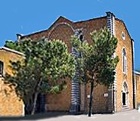
The pillars and huge arch that originally connected the crossing to the nave can be seen (both outside and inside) on what is now the left wall. The use of alternating white and black stone in the piers of San Domenico foreshadowed the more extensive use of this motif on the Duomo.
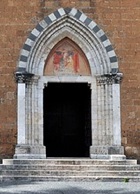
Interior
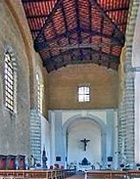
As you enter, the what was originally the wall of the left transept now provides the backdrop to the high altar. The original square apse and four apsidal chapels on the right, and the closed arch that originally connected the crossing to the nave is on the left.
The demolished body of the church comprised a nave and two narrow side aisles, all of the same height. This was typical of 13th century Dominican architecture, and was designed to facilitate preaching to large congregations.
The choir was moved from the crossing to the apse and the floor level of the apse was raised in ca. 1580. As noted above, further modifications were carried out in 1680: half of the nave and almost all of the Gothic funerary monuments in the church were destroyed at this time. The rest of the nave was destroyed in 1934. Thus, the present high altar is on what was the back wall of the left transept, and the original apse is halfway along the present nave, on the right.
[Relics and portraits of St Agnes of Montepulciano, Blessed Daniella of Orvieto???]
Cappella di San Tommaso
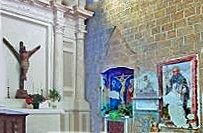
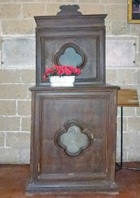
More specifically, the chapel commemorates a vision that he was said to have had here while meditating before the Crucifix on the miracle of Transubstantiation:
-
✴St Thomas heard Christ speaking to him from the Cross:
-
"Bene scripsisti de me Thoma; quam ergo mercedem accipias ?"
-
(You have written well of me, Thomas (a reference to the Office of Corpus Christi); what reward would you have?)
-
✴To which Thomas replied:
-
"Non aliam Domine nisi te ipsum"
-
(None other than Thyself, Lord).
(It has to be said that this miracle was also claimed to have happened in Naples).
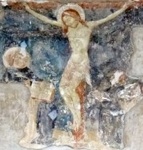
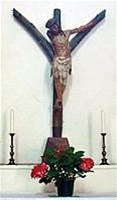
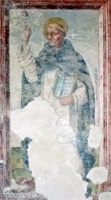
Crucifix speaks to St Thomas Aquinas Crucifix St Thomas Aquinas
(14th century?) (12th century) (14th century)
Detached fresco (14th century?)
This damaged detached fresco [on the left wall] depicts an image of Christ on the cross that speaks to St Thomas.
Crucifix (12th century)
Thcrucifix on the altar is said to include the image of Christ that actually spoke to St Thomas.
St Thomas Aquinas (14th century)
In this damaged fresco on the right, St Thomas meditates before the Crucifix, his breviary open at the Office of Corpus Christi. [Is he pointing to the Sacro Corporale?]
Crucifixion (14th or 15th century)

-
✴St Peter (on the left); and
-
✴St Paul (on the right).
Monument to Vincenzo Aviamonti (1553)
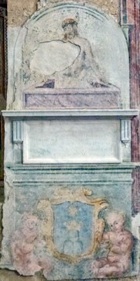
-
✴a Pietà, in which Christ rises from the tomb wearing the crown of thorns; and
-
✴two putti with a coat of arms, presumably those of the Aviamonti family.
Cappella di San Pietro Martire
This is the apsidal chapel to the left of the apse.
Frescoes (ca. 1430)
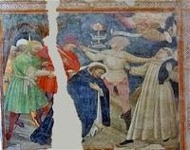
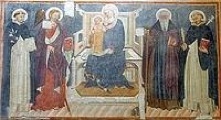
Two frescoes in the Cappella di San Pietro Martire are attributed to Pietro di Nicola Baroni:
-
✴the Martyrdom of St Peter Martyr (ca. 1430), to the left on the left wall, which depicts the murder of the saint and his companion; and
-
✴the fresco (1430), to the right on the left wall, which is dated by inscription, and which depicts the Madonna and Child enthroned and:
-
•St Dominic (carrying the lily of purity);
-
•St James (with his pilgrim's staff);
-
•St Antony Abbot (with his pig); and
-
•St Peter Martyr (with the knife that killed him still in his back).
Original Apse
The Petrucci Tomb has recently been returned to the floor of the apse. The openings on each side of the back wall lead down to the related Cappella Petrucci (also described on the page on the tomb).
Altarpieces (16th century)
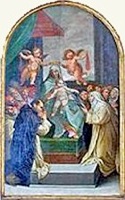

Madonna del Rosario Visitation
Two altarpieces in San Domenico are attributed to Cesare Nebbia:
-
✴The Madonna del Rosario (ca. 1575) on the left wall was commissioned for the altar of the Compagnia del Rosario. It depicts the Madonna and Child enthroned with SS Dominic and Catherine of Siena: the baby Jesus presents a rosary to St Catherine.
-
✴The Visitation (16th century) on the right wall was commissioned for the Missini family, to which the donor at the lower right presumably belonged.
Art from the Church
Panels from the San Domenico Polyptych (ca. 1321)
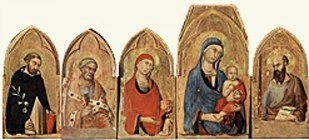
These five panels in the Museo dell' Opera del Duomo are the only ones that survive from a polyptych from San Domenico. The central panel bears the signature of Simone Martini and the date MCCCXX... (1320 or soon thereafter). The polyptych also probably had panels in an upper register and a predella below, but these have been lost.
The gallery displays the surviving panels thus:
-
✴SS Mary Magdalene, Dominic and Peter on the left; and
-
✴St Paul on the right.
If (as seems likely) this is their original disposition, there must have been two other panels in this register depicting saints (probably of SS Peter Martyr and Catherine of Alexandria, to the sides of St Paul) looking to the left. The lovely figures of SS Peter and Paul are markedly more lifelike than the others, which have suffered from over-restoration and may in any case have been workshop productions.
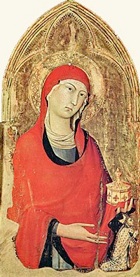
Return to Monuments of Orvieto.
Continue to Monument to Cardinal de Bray Petrucci Tomb and Chapel.
Return to Walk III.

